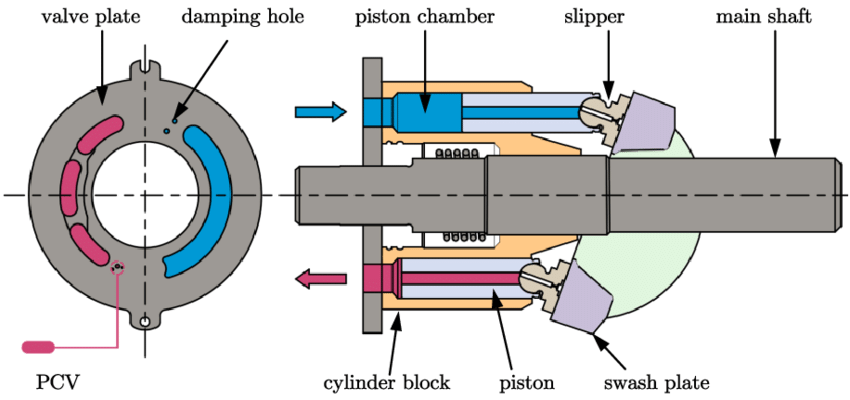Piston pumps are reliable in operation, have good suction capacity, and can create high discharge pressures, but they have a large mass and a rather complex device.
Piston pumps are used as circulation, oil, fuel pumps, and others. On modern tankers, they are used as cargo pumps (for pumping liquid cargo). Rotary piston pumps are used in hydraulic steering drives, as they can provide a change in the direction and speed of the rudder shift at a constant speed.
How does it work?
The principle of operation of a piston pump is that the piston, reciprocating and moving in one direction, creates a discharge in the cylinder. The suction valve opens, and water enters the cylinder due to the pressure difference. Moving in the opposite direction, the piston presses on the liquid, creating pressure. The suction valve closes, the discharge valve opens, and the liquid is forced into the pressure line.
Advantages and disadvantages of this type of pumps.
Advantages:
- Ability to create high pressure – 2-4 MPa.
- Ability to provide dry suction.
- High volumetric efficiency – up to 0.99.
- Constant pressure when adjusting the feed by changing the speed of rotation.
Disadvantages:
- Uneven supply.
- Large weight and dimensions.
- High cost of manufacturing and repair.
- High sensitivity to the frequency of the pumped liquid.
- The presence of valves leads to frequent failure of pumps.
Piston pump malfunctions
The pump does not create a nominal head at a nominal number of strokes:
- The intake or drain valves of the pump are faulty, foreign objects have fallen under the valves – inspect the valves, clean if necessary, grind, check the lifting of the valves and the stiffness of the springs.
- The valve grate gasket of the pump is faulty – replace the gasket.
- The sealing rings of hydraulic pistons are worn or broken – replace the rings.
 Rotary Piston Pump
Rotary Piston Pump
The appearance of knocks in the pump:
- Slack in the rod mounting assembly on the piston (metal knock when changing stroke) – stop the pump, fix the piston on the rod.
- Severe wear of bearings, bushings, piston pins, and seals – repair or replace worn parts.
- Valve springs breakage, large valve lift – replace springs, adjust valve lift.
- Hydraulic shocks in the pump – adjust the amount of air in the air caps; eliminate air suction or vaporization of the pumped liquid.
When the fresh steam valve is opened, the direct-acting steam pump does not start:
- Any of the exhaust steam taps is closed – check the system, open the valves.
- Fresh steam pressure is not enough – raise the steam pressure.
- The oil seals are strongly clamped and skewed – give the oil seals, eliminate the distortions.
The appearance of knocks in the steam cylinder:
- Large stroke of pistons – check and adjust the steam distribution of the pump.
- Presence of water in the cylinders – purge the cylinders.
- Wear of piston rings or piston grooves – replace the rings, repair the piston.

VARIABLE DISPLACEMENT PISTON PUMP
Contact Us!
Breezemarine Group offers all types of pumps of the world famous brands, including piston type. We provide fast and reliable service to help your vessel operate smoothly.
If you’re looking for other spare parts, such as turbochargers, heat exchangers, and many more, don’t hesitate to check our website.
Fill out the form on our website or call us today to find out how we could assist you to succeed with your maritime needs.
